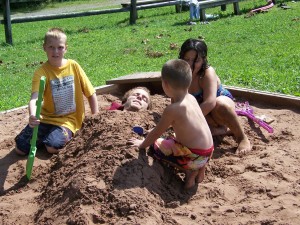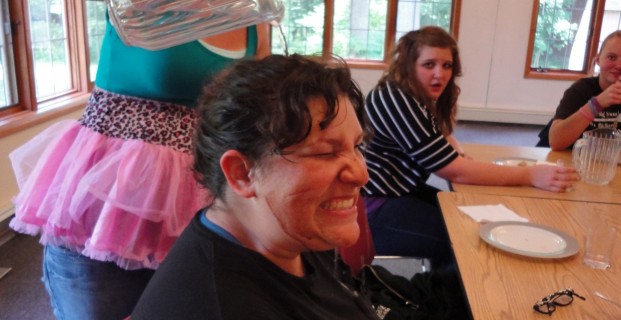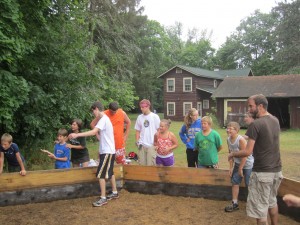Zero tolerance for Zero Tolerance, a few ounces of prevention, and a pound of cure.
Hi. This is a 5 part series on effectively preventing the formation of a culture of bullying at your camp. I’ll share this intro in all 4 steps, so if you’re coming to the article from a later step – please feel free to skip ahead!
When I was in sixth grade, I was bullied pretty consistently by one specific person. I walked around the hallway each day for several months fearing that he would corner me and attempt to intimidate me. He never hit me or physically attacked me in any way, but the threats were so consistent that it ate away at my ability to reason. He threatened that if I ever told anyone, I’d be in serious trouble. So I didn’t. Eventually it stopped, but the remnants of the feelings I had while being bullied still live on in me today.
When I was a summer camp counselor, I bought fully into the “zero tolerance” approach that’s very common in schools today. Any time I witnessed any bullying, I would take the bully aside and, well, bully him. I’d use threats that he would be sent home from camp, told him that his parents would be disappointed in him, and told him that I was disappointed in him. Sometimes this worked, and I’d pat myself on the back. Sometimes it didn’t, and I would consider the bully a lost cause, figuring that I’d at least tried my best. I used this approach through 2006, and thought myself a proper crusader against bullying. A real knight in shining armor.
But then the data came in
 To many people’s surprise, including mine, the use of zero-tolerance policies has shown to have no effect at best, and negative effects at worst. With everyone from the NEA to the APA coming together in opposition to zero tolerance policies, it’s pretty surprising that such policies are used in so many environments.
To many people’s surprise, including mine, the use of zero-tolerance policies has shown to have no effect at best, and negative effects at worst. With everyone from the NEA to the APA coming together in opposition to zero tolerance policies, it’s pretty surprising that such policies are used in so many environments.
To be clear, I know that the implementation of zero-tolerance policies comes from a good place. People see a real problem in the world, and seek to fix it. They see someone whom they believe to be an aggressor, and someone whom they believe to be a victim, and attempt to intervene. As a former bullied person and zero-tolerance warrior myself, I totally get it.
But it isn’t working. The only real effect that zero tolerance policies seem to have is to create the illusion in the minds of the enforcers that something is being done to solve the problem. Something’s being done, but it’s solving nothing.
The ounces of prevention
Now, I understand that it’s not always possible to stop bullying before it starts. We dealt with a bullying issue last summer that still troubles me. It felt like it shouldn’t have been possible, but there it was. I suppose it’s important to always remind ourselves, as camp directors, that we’re ultimately in control of a lot less than we think we are.
But there are things that we can do – real things – with demonstrable results. I’d like to share them with you, and share why I feel I can advertise my camp as the “safest place from teasing and bullying on the planet.”
Here’s a brief list of what we’ve done, and I’ll dive into the specifics below.
We:
1) Changed how we supervised our campers.
2) Mixed ages whenever possible.
3) Changed the way we affirm our campers.
4) Eliminated all but 3 of our rules.
5) Offered freedom of association.
Let’s dive into them with step 1:
Transcending Supervision
Supervision has a lot of benefits that everyone is aware of, so I’ll try not to belabor them here. When counselors are present, kids are less likely to be mean to each other, period. When counselors are present, they can give an unbiased account of what has gone on. Et cetera. But this base-level supervision still leaves tremendous gaps in our coverage. I’ll share how we’ve changed up our whole concept of supervision so that counselors can be more effective when they are in the presence of these kids.
I attended a workshop of Scott Arizala’s a couple of years ago that framed the whole concept of supervision for me in a new way. He goes into great detail on this concept in a recent episode of the Scott Arizala Show over at Camp Hacker.
Essentially, it boils down to this: we need to train our staff in the art of “noticing.” That is, having a moment of mindfulness where the counselor says to himself, “How can I make this situation better right now?” And once they became master noticers, we need to give them the tools to address the issues they’ve noticed.
Practicing Engagement instead of Supervision
 To say we’re “supervising” kids sort of leaves out most of the important parts of what we’re doing at summer camp – so I prefer the term “engagement.” As a camp that offers a lot of free play and free interaction between kids, we train our staff to look for the five different states of being that kids can be in, to prioritize them as follows, and handle the engagement of them in the ways described below:
To say we’re “supervising” kids sort of leaves out most of the important parts of what we’re doing at summer camp – so I prefer the term “engagement.” As a camp that offers a lot of free play and free interaction between kids, we train our staff to look for the five different states of being that kids can be in, to prioritize them as follows, and handle the engagement of them in the ways described below:
1) The kid that’s actively sad.
Kind of a no-brainer, here – if a kid is actively sad, you go over and talk to him.
2) A camper that is alone, and unoccupied.
Frequently this child will just be zoning out, but occasionally, there’s a reason that she is sitting alone. When we open a door to conversation with a child who is sitting alone, we may unearth a molehill before it becomes a mountain. The true toxicity of bullying needs time to ferment, and checking in with campers who are alone is the first step in ferreting out if any negative feelings have taken root.
3) Campers who are just hanging out.
Campers who are not focused on a particular activity run a higher risk of engaging in teasing or bullying behavior than campers who are actively engaging in an activity. This does not mean we should deny campers the opportunity to just hang out with each other.
“But, James!” you’re saying aloud, while freaking out the people in your office, “I thought you said we were supposed to be preventing bullying and teasing! If we can eliminate down time, we can eliminate bullying, right!?”
My response to this is: rarely. You see, unless you can eliminate ALL interactions between kids outside of your structured activities, they are going to have the opportunity to interact without a focused activity at some point. Even if it’s after they leave camp.
And our goal at camp isn’t just to eliminate bullying at camp, right? It’s to help kids build habits to help them avoid bullying situations in the future.
Right. Much better than eliminating times where kids can just sit and chat is to just encourage your staff to go over and be a part of the conversation. If you follow some of the other steps later in this list, your staff will be seen as credible, “cool,” and responsible – and will be welcomed into conversations instead of met with silence or eye-rolling. Joining in these “down time” conversations will naturally steer them towards positive, life-affirming subjects, rather than negative ones.
Staff members can be given specific tools (more on this in the rules section) that can steer conversation away from teasing or bullying without taking away from everyone’s fun. When effective and likeable staff are present, bullying habits simply can not take root. Empowering staff to notice kids that are just hanging out, and to engage them appropriately, can make a world of difference.
4) Kids actively engaged in a competitive activity.
You are probably already guessing as to why the “competitive” piece matters, but I’ll go ahead and spell it out anyway. When kids feel like something is at stake in an activity, they are far more likely to point out the shortcomings of others, and to be sensitive to their own shortcomings. Now, kids that are competing in a card game are less likely to get on each other’s case than kids who are playing basketball, but there is potential for mistreatment and hurt feelings in any activity where winners and losers are found.The engagement that takes place in a competitive activity is much like the engagement that takes place when kids are just hanging out – but it’s a little trickier to navigate. The principal reason for this is that when counselors are actively involved in the competition, they may share the same feelings of those campers that are upset with others! An over-competitive staff member might also be frustrated that someone isn’t passing the ball, or with a player on the other team who is ‘breaking the rules,’ or any number of reasons. A frustrated staff member might let out a, “Now, guys, don’t say that,” when his team ridicules a “ball-hog,” but if he is half-hearted in his addressing of them, it can come off as even affirming of the negativity.
Thus, staff members need to be trained to be fully present as counselors first in these activities, rather than participants.
The first step, as many camps already do, is to have the staff person de-emphasize winning above all else. There are a zillion ways to make a classically competitive game more about fun than winning, and I’ll probably write an article on that some day if people are interested.
The second step sounds both obvious and silly, but all staff members need to be acting like they are having fun. Counselors set the tone in competitive activities more than any other activities. We’ve all seen how a counselor who is steaming during a game of capture the flag can ruin his entire team’s mood. This is unacceptable behavior, and it needs to be curbed immediately. If a summer staff member is unable to do this, he needs to observe the activity rather than participate in it.
The last step is critical, and often overlooked while in the moment of a fast-paced activity like soccer, or capture the flag. Campers expressing frustration in the middle of a game are frequently left to their own devices after a quick chiding, and by the time the game is over, the moments of frustration are forgotten to most. The problem is that those moments of frustration have not been forgotten by the campers others were frustrated with. Debriefing competitive activities is absolutely essential – especially when there were any moments of frustration that arose.
Talking to both the frustrated parties and the person whom others were frustrated with is a mandatory last step that often gets forgotten, and it can actively prevent bullying patterns from taking root. When people are frustrated in the context of a game, and that frustration is never addressed when the game is over, a situation has arisen where it has become acceptable to act in frustrated ways with certain members of our community.
Active engagement and follow-up are principally valuable in preventing bullying because they can head-off bad habits before they begin. By observing frustration via supervision and engagement, and following up on it with all involved parties afterward, we give our camp community tools for growing from these moments of frustration, rather than letting them fester into larger, community damaging problems.
5) Kids who are actively engaged in a non-competitive activity
At Vanderkamp, most of the magic happens in activities like these. Naturally, we try to foster as many activities like these as possible. The role of staff in non-competitive activities is simple: be the most enthusiastic participant in the group. A fully engaged staff member will have contagious enthusiasm that gives campers “permission” to go all out, as well. This not only makes bullying and teasing incredibly unlikely in the moment, but it is an investment in the future positive attitudes of everyone who is participating. Kids who have just come back from covering themselves in mud and trying to sneak up on the maintenance staff never bully others. They just don’t.
You know you’re engaging, and not supervising, when…
You know you’ve sped past being a supervisor and become an engager when you spend about 1% of your time supervising, and 99% of your time engaging. Engagement is about being present in the moment with campers, and letting them know that you are a companion alongside them on a journey. A supervisor who isn’t actively engaging kids can remind kids of supervisors in other areas of their life: people who are there to ensure no one breaks the rules, and little else.
A staff of supervisors leads to a group of campers who are trying to get away with things. A staff of engagers leads to a culture of companionship, where campers are actively bringing staff into their conversations and activities, rather than hiding what they enjoy doing and talking about for fear of punishment.
A staff of engagers lays the critical foundation for life-affirming habits, and can get campers away from the negative habits they may have formed due to the interpersonal-intelligence related learning-loss that can take place during the school year.
Now, proper staff engagement isn’t everything, but it’s a mandatory foundation upon which any culture that hopes to prevent bullying is laid. The next four steps will be rolled out in the next few weeks – if you want to be updated when these come out, make sure to sign up for our email list below!



James,
I am so glad you wrote this out! I think it’s really helpful to have a comprehensive step-by-step guide to think about when you’re facing these situations..being present, involved and engaged with the kids is one of the greatest things I learned from you and the greatest way to prevent bullying–and I’ve also found not letting anything slide helps–as in point out and address instantly what thing to say/behavior is not okay(for example, sometimes my kids don’t know that something they said could be seen as bullying)–rather than just let it go. Stopping what you’re doing and having serious conversations about how that word/behavior may affect others also seems to curb bullying in my experience (not in a shaming way–keeping in mind that there are no ‘bad’ or ‘mean-spirited’ kids)–but doing this kindly and respectfully..because sometimes the kids just don’t know any better–and eventually, you’ll have to stop less and less because the kids start catching themselves as they notice unkind things they may say/do.
What do you think?
I can’t wait to read your next articles!
Thanks, Hannah! I really appreciate your kind words, and am so glad that everything we’ve done at VK is translating to the rest of your world! What you’re describing is commonly called a ‘time-in’ (as opposed to a time-out). I think you’re really on to something, and I’m going to get to this later in this series — when we cut our rules down the bare essentials, but then get really serious about the rules we do keep, kids often respond to that consistency. Thanks for taking the time out of your day to respond!